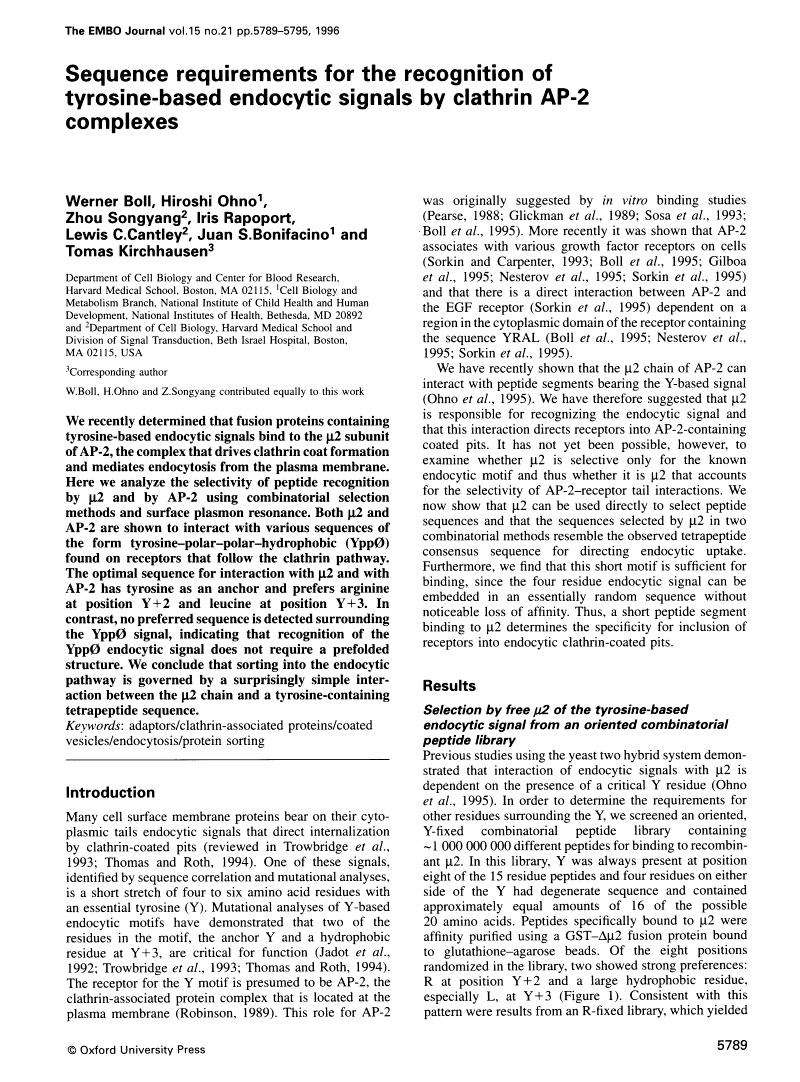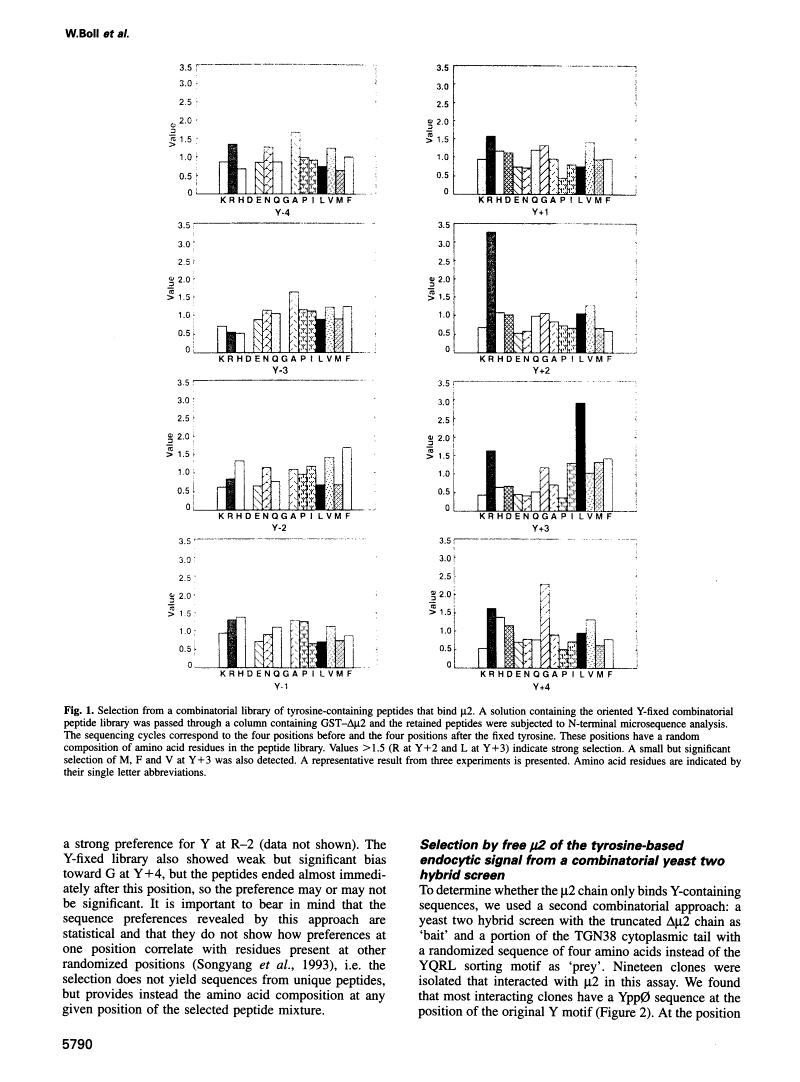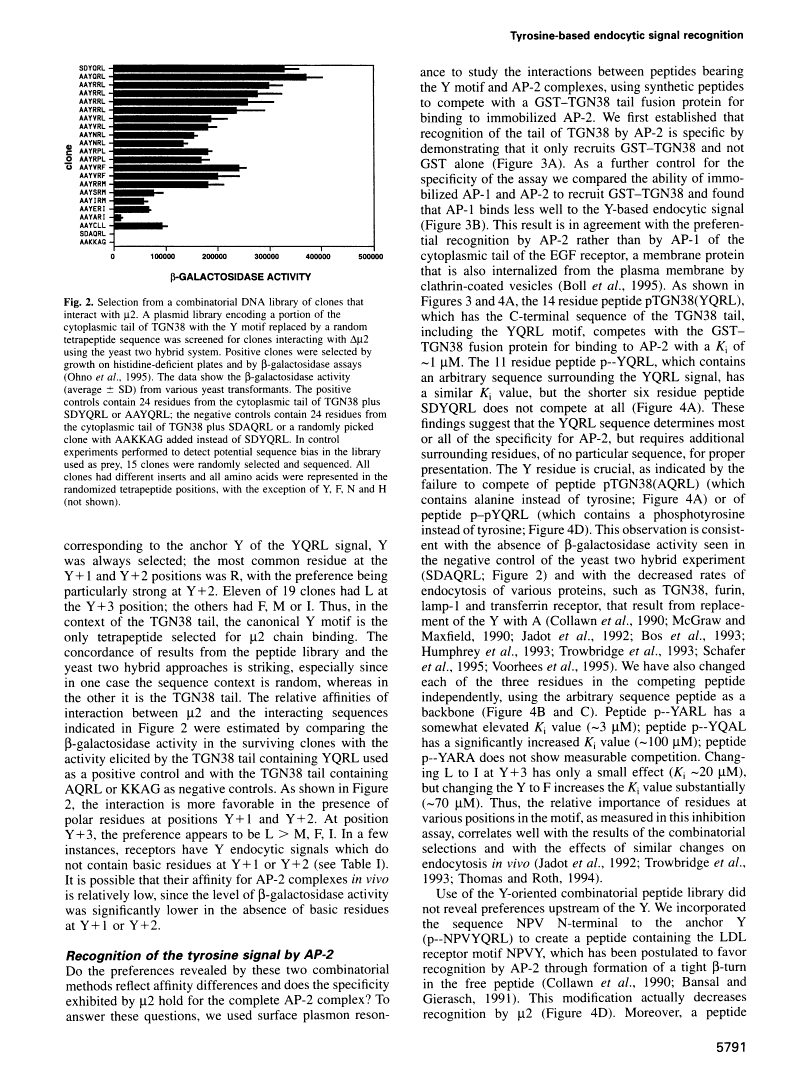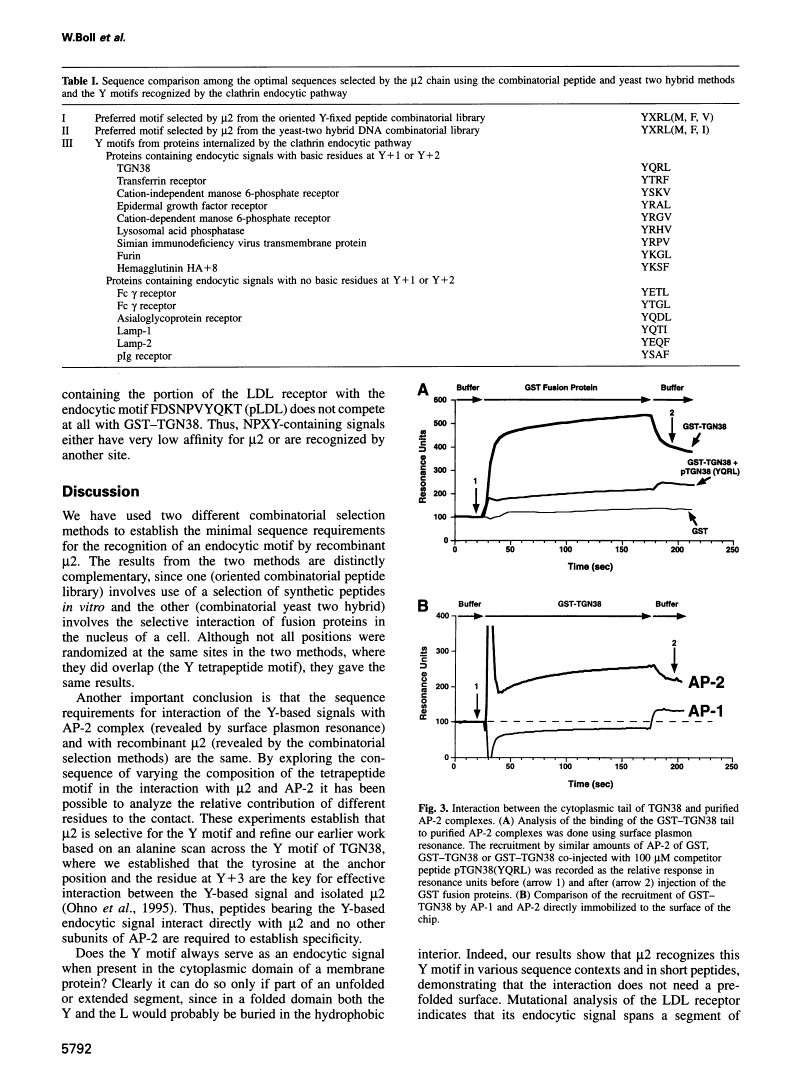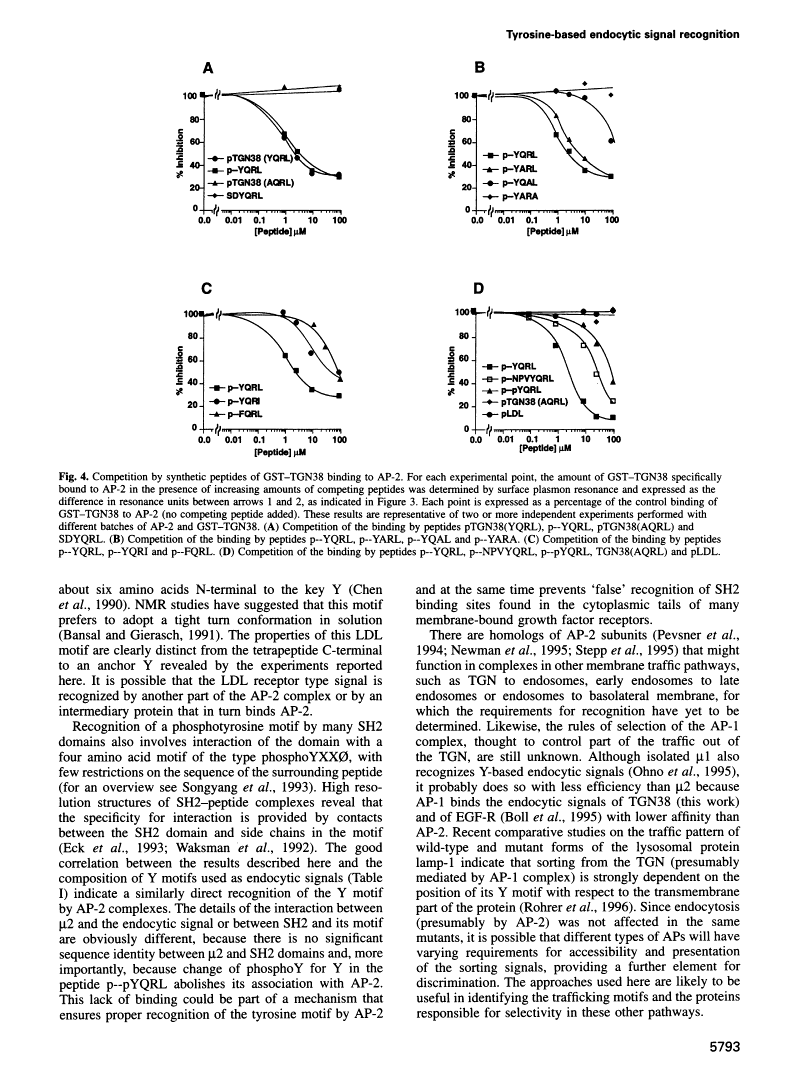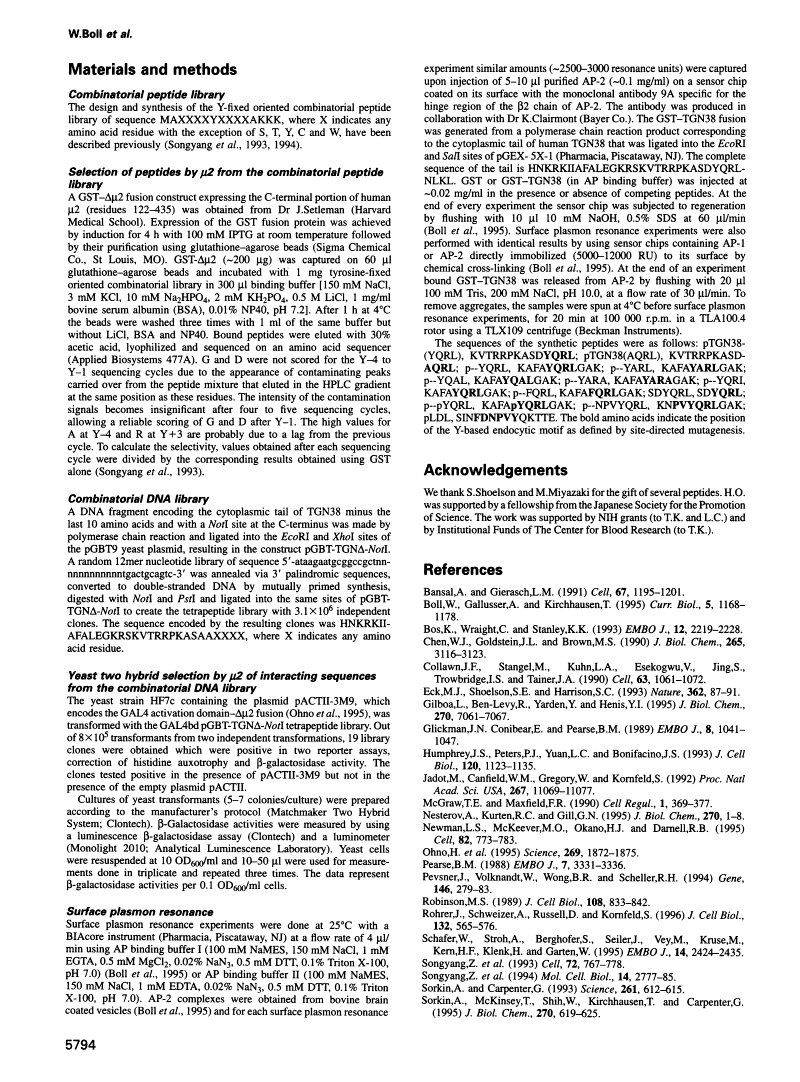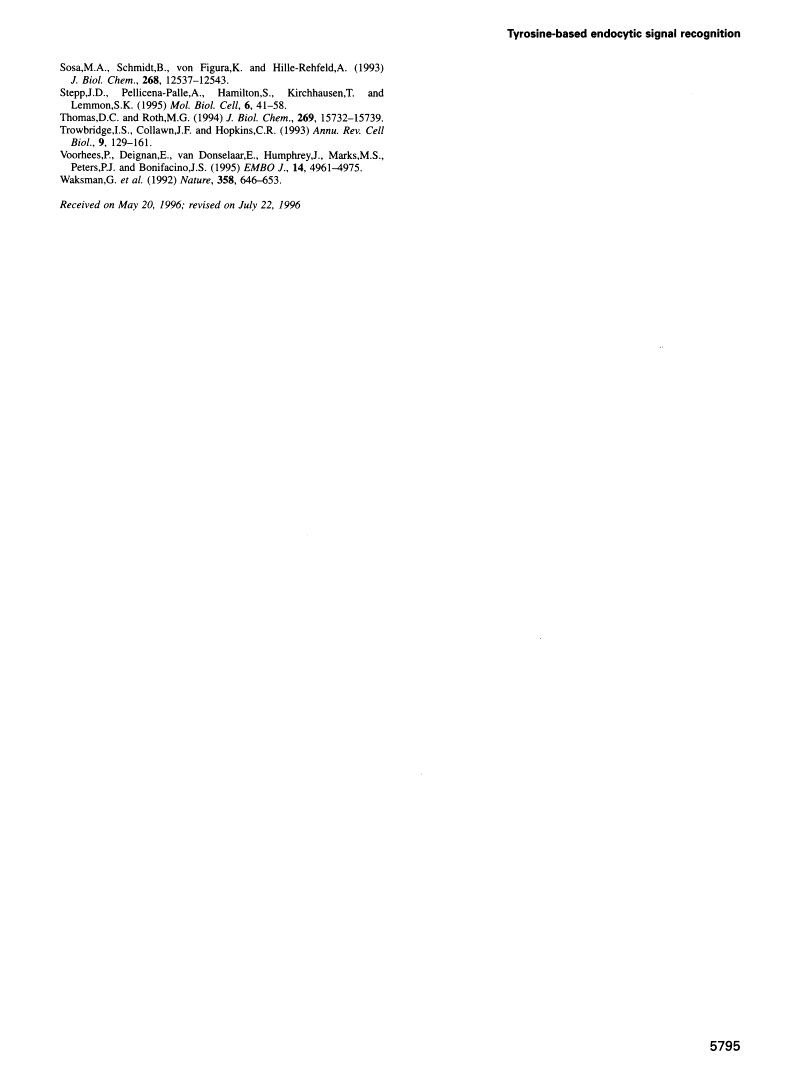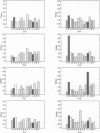Abstract
Free full text

Sequence requirements for the recognition of tyrosine-based endocytic signals by clathrin AP-2 complexes.
Abstract
We recently determined that fusion proteins containing tyrosine-based endocytic signals bind to the mu 2 subunit of AP-2, the complex that drives clathrin coat formation and mediates endocytosis from the plasma membrane. Here we analyze the selectivity of peptide recognition by mu 2 and by AP-2 using combinatorial selection methods and surface plasmon resonance. Both mu 2 and AP-2 are shown to interact with various sequences of the form tyrosine-polar-polar-hydrophobic (Yppø) found on receptors that follow the clathrin pathway. The optimal sequence for interaction with mu 2 and with AP-2 has tyrosine as an anchor and prefers arginine at position Y + 2 and leucine at position Y + 3. In contrast, no preferred sequence is detected surrounding the Yppø signal, indicating that recognition of the Yppø endocytic signal does not require a prefolded structure. We conclude that sorting into the endocytic pathway is governed by a surprisingly simple interaction between the mu 2 chain and a tyrosine-containing tetrapeptide sequence.
Full text
Full text is available as a scanned copy of the original print version. Get a printable copy (PDF file) of the complete article (1.3M), or click on a page image below to browse page by page. Links to PubMed are also available for Selected References.
Images in this article
Click on the image to see a larger version.
Selected References
These references are in PubMed. This may not be the complete list of references from this article.
- Bansal A, Gierasch LM. The NPXY internalization signal of the LDL receptor adopts a reverse-turn conformation. Cell. 1991 Dec 20;67(6):1195–1201. [Abstract] [Google Scholar]
- Boll W, Gallusser A, Kirchhausen T. Role of the regulatory domain of the EGF-receptor cytoplasmic tail in selective binding of the clathrin-associated complex AP-2. Curr Biol. 1995 Oct 1;5(10):1168–1178. [Abstract] [Google Scholar]
- Bos K, Wraight C, Stanley KK. TGN38 is maintained in the trans-Golgi network by a tyrosine-containing motif in the cytoplasmic domain. EMBO J. 1993 May;12(5):2219–2228. [Europe PMC free article] [Abstract] [Google Scholar]
- Chen WJ, Goldstein JL, Brown MS. NPXY, a sequence often found in cytoplasmic tails, is required for coated pit-mediated internalization of the low density lipoprotein receptor. J Biol Chem. 1990 Feb 25;265(6):3116–3123. [Abstract] [Google Scholar]
- Collawn JF, Stangel M, Kuhn LA, Esekogwu V, Jing SQ, Trowbridge IS, Tainer JA. Transferrin receptor internalization sequence YXRF implicates a tight turn as the structural recognition motif for endocytosis. Cell. 1990 Nov 30;63(5):1061–1072. [Abstract] [Google Scholar]
- Eck MJ, Shoelson SE, Harrison SC. Recognition of a high-affinity phosphotyrosyl peptide by the Src homology-2 domain of p56lck. Nature. 1993 Mar 4;362(6415):87–91. [Abstract] [Google Scholar]
- Gilboa L, Ben-Levy R, Yarden Y, Henis YI. Roles for a cytoplasmic tyrosine and tyrosine kinase activity in the interactions of Neu receptors with coated pits. J Biol Chem. 1995 Mar 31;270(13):7061–7067. [Abstract] [Google Scholar]
- Glickman JN, Conibear E, Pearse BM. Specificity of binding of clathrin adaptors to signals on the mannose-6-phosphate/insulin-like growth factor II receptor. EMBO J. 1989 Apr;8(4):1041–1047. [Europe PMC free article] [Abstract] [Google Scholar]
- Humphrey JS, Peters PJ, Yuan LC, Bonifacino JS. Localization of TGN38 to the trans-Golgi network: involvement of a cytoplasmic tyrosine-containing sequence. J Cell Biol. 1993 Mar;120(5):1123–1135. [Europe PMC free article] [Abstract] [Google Scholar]
- Jadot M, Canfield WM, Gregory W, Kornfeld S. Characterization of the signal for rapid internalization of the bovine mannose 6-phosphate/insulin-like growth factor-II receptor. J Biol Chem. 1992 Jun 5;267(16):11069–11077. [Abstract] [Google Scholar]
- McGraw TE, Maxfield FR. Human transferrin receptor internalization is partially dependent upon an aromatic amino acid on the cytoplasmic domain. Cell Regul. 1990 Mar;1(4):369–377. [Europe PMC free article] [Abstract] [Google Scholar]
- Taussig R, Gilman AG. Mammalian membrane-bound adenylyl cyclases. J Biol Chem. 1995 Jan 6;270(1):1–4. [Abstract] [Google Scholar]
- Newman LS, McKeever MO, Okano HJ, Darnell RB. Beta-NAP, a cerebellar degeneration antigen, is a neuron-specific vesicle coat protein. Cell. 1995 Sep 8;82(5):773–783. [Abstract] [Google Scholar]
- Ohno H, Stewart J, Fournier MC, Bosshart H, Rhee I, Miyatake S, Saito T, Gallusser A, Kirchhausen T, Bonifacino JS. Interaction of tyrosine-based sorting signals with clathrin-associated proteins. Science. 1995 Sep 29;269(5232):1872–1875. [Abstract] [Google Scholar]
- Pearse BM. Receptors compete for adaptors found in plasma membrane coated pits. EMBO J. 1988 Nov;7(11):3331–3336. [Europe PMC free article] [Abstract] [Google Scholar]
- Pevsner J, Volknandt W, Wong BR, Scheller RH. Two rat homologs of clathrin-associated adaptor proteins. Gene. 1994 Sep 2;146(2):279–283. [Abstract] [Google Scholar]
- Robinson MS. Cloning of cDNAs encoding two related 100-kD coated vesicle proteins (alpha-adaptins). J Cell Biol. 1989 Mar;108(3):833–842. [Europe PMC free article] [Abstract] [Google Scholar]
- Rohrer J, Schweizer A, Russell D, Kornfeld S. The targeting of Lamp1 to lysosomes is dependent on the spacing of its cytoplasmic tail tyrosine sorting motif relative to the membrane. J Cell Biol. 1996 Feb;132(4):565–576. [Europe PMC free article] [Abstract] [Google Scholar]
- Schäfer W, Stroh A, Berghöfer S, Seiler J, Vey M, Kruse ML, Kern HF, Klenk HD, Garten W. Two independent targeting signals in the cytoplasmic domain determine trans-Golgi network localization and endosomal trafficking of the proprotein convertase furin. EMBO J. 1995 Jun 1;14(11):2424–2435. [Europe PMC free article] [Abstract] [Google Scholar]
- Songyang Z, Shoelson SE, Chaudhuri M, Gish G, Pawson T, Haser WG, King F, Roberts T, Ratnofsky S, Lechleider RJ, et al. SH2 domains recognize specific phosphopeptide sequences. Cell. 1993 Mar 12;72(5):767–778. [Abstract] [Google Scholar]
- Songyang Z, Shoelson SE, McGlade J, Olivier P, Pawson T, Bustelo XR, Barbacid M, Sabe H, Hanafusa H, Yi T, et al. Specific motifs recognized by the SH2 domains of Csk, 3BP2, fps/fes, GRB-2, HCP, SHC, Syk, and Vav. Mol Cell Biol. 1994 Apr;14(4):2777–2785. [Europe PMC free article] [Abstract] [Google Scholar]
- Sorkin A, Carpenter G. Interaction of activated EGF receptors with coated pit adaptins. Science. 1993 Jul 30;261(5121):612–615. [Abstract] [Google Scholar]
- Sorkin A, McKinsey T, Shih W, Kirchhausen T, Carpenter G. Stoichiometric interaction of the epidermal growth factor receptor with the clathrin-associated protein complex AP-2. J Biol Chem. 1995 Jan 13;270(2):619–625. [Abstract] [Google Scholar]
- Sosa MA, Schmidt B, von Figura K, Hille-Rehfeld A. In vitro binding of plasma membrane-coated vesicle adaptors to the cytoplasmic domain of lysosomal acid phosphatase. J Biol Chem. 1993 Jun 15;268(17):12537–12543. [Abstract] [Google Scholar]
- Stepp JD, Pellicena-Palle A, Hamilton S, Kirchhausen T, Lemmon SK. A late Golgi sorting function for Saccharomyces cerevisiae Apm1p, but not for Apm2p, a second yeast clathrin AP medium chain-related protein. Mol Biol Cell. 1995 Jan;6(1):41–58. [Europe PMC free article] [Abstract] [Google Scholar]
- Thomas DC, Roth MG. The basolateral targeting signal in the cytoplasmic domain of glycoprotein G from vesicular stomatitis virus resembles a variety of intracellular targeting motifs related by primary sequence but having diverse targeting activities. J Biol Chem. 1994 Jun 3;269(22):15732–15739. [Abstract] [Google Scholar]
- Trowbridge IS, Collawn JF, Hopkins CR. Signal-dependent membrane protein trafficking in the endocytic pathway. Annu Rev Cell Biol. 1993;9:129–161. [Abstract] [Google Scholar]
- Voorhees P, Deignan E, van Donselaar E, Humphrey J, Marks MS, Peters PJ, Bonifacino JS. An acidic sequence within the cytoplasmic domain of furin functions as a determinant of trans-Golgi network localization and internalization from the cell surface. EMBO J. 1995 Oct 16;14(20):4961–4975. [Europe PMC free article] [Abstract] [Google Scholar]
- Waksman G, Kominos D, Robertson SC, Pant N, Baltimore D, Birge RB, Cowburn D, Hanafusa H, Mayer BJ, Overduin M, et al. Crystal structure of the phosphotyrosine recognition domain SH2 of v-src complexed with tyrosine-phosphorylated peptides. Nature. 1992 Aug 20;358(6388):646–653. [Abstract] [Google Scholar]
Associated Data
Articles from The EMBO Journal are provided here courtesy of Nature Publishing Group
Full text links
Read article at publisher's site: https://doi.org/10.1002/j.1460-2075.1996.tb00965.x
Read article for free, from open access legal sources, via Unpaywall:
https://onlinelibrary.wiley.com/doi/pdfdirect/10.1002/j.1460-2075.1996.tb00965.x
Citations & impact
Impact metrics
Citations of article over time
Article citations
A Novel Homozygous Germline Mutation in Transferrin Receptor 1 (TfR1) Leads to Combined Immunodeficiency and Provides New Insights into Iron-Immunity Axis.
J Clin Immunol, 44(2):55, 25 Jan 2024
Cited by: 1 article | PMID: 38270687 | PMCID: PMC10811203
A specialized tyrosine-based endocytosis signal in MR1 controls antigen presentation to MAIT cells.
J Cell Biol, 221(12):e202110125, 21 Sep 2022
Cited by: 7 articles | PMID: 36129434 | PMCID: PMC9499830
Weakly Internalized Receptors Use Coated Vesicle Heterogeneity to Evade Competition during Endocytosis.
Biochemistry, 60(27):2195-2205, 25 Jun 2021
Cited by: 2 articles | PMID: 34170686 | PMCID: PMC8483609
Cytoplasmic short linear motifs in ACE2 and integrin β3 link SARS-CoV-2 host cell receptors to mediators of endocytosis and autophagy.
Sci Signal, 14(665):eabf1117, 12 Jan 2021
Cited by: 55 articles | PMID: 33436498 | PMCID: PMC7928716
AAGAB Controls AP2 Adaptor Assembly in Clathrin-Mediated Endocytosis.
Dev Cell, 50(4):436-446.e5, 25 Jul 2019
Cited by: 24 articles | PMID: 31353312 | PMCID: PMC6702059
Go to all (156) article citations
Data
Similar Articles
To arrive at the top five similar articles we use a word-weighted algorithm to compare words from the Title and Abstract of each citation.
The sequence NPFXD defines a new class of endocytosis signal in Saccharomyces cerevisiae.
J Cell Biol, 135(6 pt 2):1789-1800, 01 Dec 1996
Cited by: 71 articles | PMID: 8991091 | PMCID: PMC2133951
Mu 2 binding directs the cystic fibrosis transmembrane conductance regulator to the clathrin-mediated endocytic pathway.
J Biol Chem, 276(49):46251-46259, 17 Sep 2001
Cited by: 33 articles | PMID: 11560923
Regulatory interactions in the recognition of endocytic sorting signals by AP-2 complexes.
EMBO J, 16(9):2240-2250, 01 May 1997
Cited by: 125 articles | PMID: 9171339 | PMCID: PMC1169826
Linking cargo to vesicle formation: receptor tail interactions with coat proteins.
Curr Opin Cell Biol, 9(4):488-495, 01 Aug 1997
Cited by: 228 articles | PMID: 9261055
Review
